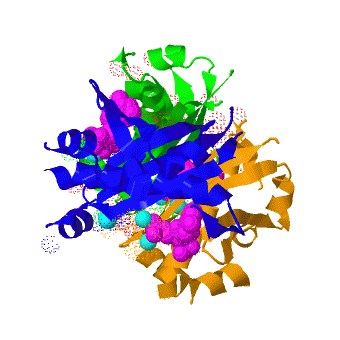The crystal structure of Acyl carrier protein synthase (AcpS) from Mycobacterium tuberculosis (Mtb) was solved at 1.95 Å (3hqj). It crystallized as one per asymmetric unit. Since Mtb AcpS has biologically active trimeric arrangement, (in green, blue, and (in orange) was constructed using the 3-fold crystallographic symmetry in the P23 space group.
The 3′,5′-ADP moieties of the coenzyme A (CoA, colored magenta), are positioned in the cleft between each of two monomers forming three active sites within AcpS trimer. The is formed by the residues D9 (highly conserved), E58, L62, and S65 from monomer A and by R92, P93, R53, H116, and T115 from the neighboring monomer B. The residues labeled and shown as sticks (A and B in the brackets point on the name of the monomer). Hydrogen bonds are shown as dashed lines with interatomic distances in Å. The magnesium (Mg) atoms are shown in spacefill representation and colored in cyan. The CoA is shown in stick representation and colored magenta. Nitrogen and oxygen atoms of the CoA 3′,5′-ADP moiety and of the active site resudues are colored blue and red, respectively.
of the structures of the Mtb AcpS trimer (in green, blue, and orange) and the B. subtilis AcpS trimer (1f7t, in red, cyan, and yellow) reveals that the Mtb AcpS structure is similar to those of other members of group I phosphopantetheine transferase (PPT) family. The is that the extended α3 helix of Mtb AcpS has open conformation. Such open conformation permits to the extended loop of one monomer (green) to interact with adjacent monomer (blue). The considerably shorter α3 of one B. subtilis AcpS monomer (red) has closed conformation and this doesn't allow interaction with the neighboring monomer (cyan).
The B. subtilis AcpS trimer (1f80) three molecules of the acyl carrier protein (ASP). The interactions between B. subtilis AcpS and ACP are predominantly . The B. subtilis AcpS (white) is shown in spacefill representation, the agrinines, lysines, and histidines are colored blue, while aspartates and glutamates are colored red. The ACP molecule (green) is shown in ribbon representation with aspartates and glutamates as sticks and colored red. The B. subtilis AcpS has large with ASP. of Mtb AcpS surface using the similar orientation as B. subtilis AcpS, shows a moderate electronegative nature in the putative ACP binding site near the ASP 15. The Mtb ASPM structure (1klp, corresponding to ACP) demonstrates considerably lower negative charge. So, the electrostatic interactions between Mtb AcpS and ASPM are, probably, less important.
PPT subtypes are the E. coli ACPS and the B. subtilis Sfp. For details on Spf see Molecular Playground/4'-PHOSPHOPANTETHEINYL TRANSFERASE (Sfp).
- Beta-ketoacyl-acyl carrier protein synthase II is involved in temperature controlled fatty acid synthesis[1].
See also Acyl carrier protein, Fatty acid synthesis.
3D structures of acyl carrier protein synthase
Acyl carrier protein synthase 3D structures

